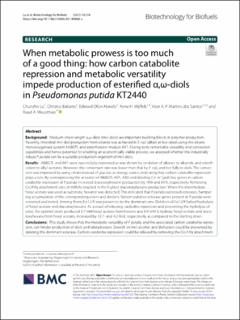| dc.contributor.author | Lu, Chunzhe | |
| dc.contributor.author | Batianis, Christos | |
| dc.contributor.author | Akwafo, Edward Ofori | |
| dc.contributor.author | Wijffels, Rene Hubertus | |
| dc.contributor.author | Martins dos Santos, Vitor A.P. | |
| dc.contributor.author | Weusthuis, Ruud A. | |
| dc.date.accessioned | 2022-07-13T12:31:17Z | |
| dc.date.available | 2022-07-13T12:31:17Z | |
| dc.date.created | 2021-12-02T15:38:44Z | |
| dc.date.issued | 2021 | |
| dc.identifier.citation | Lu, C., Batianis, C., Akwafo, E.O., Wijffels, R. H., Martins dos Santos, V. A. P. & Weusthuis, R. A. (2021). When metabolic prowess is too much of a good thing: how carbon catabolite repression and metabolic versatility impede production of esterified α,ω-diols in Pseudomonas putida KT2440. Biotechnology for Biofuels, 14(1): 218. doi: | en_US |
| dc.identifier.issn | 1754-6834 | |
| dc.identifier.uri | https://hdl.handle.net/11250/3005064 | |
| dc.description.abstract | Background: Medium-chain-length α,ω-diols (mcl-diols) are important building blocks in polymer production. Recently, microbial mcl-diol production from alkanes was achieved in E. coli (albeit at low rates) using the alkane monooxygenase system AlkBGTL and esterification module Atf1. Owing to its remarkable versatility and conversion capabilities and hence potential for enabling an economically viable process, we assessed whether the industrially robust P. putida can be a suitable production organism of mcl-diols. Results: AlkBGTL and Atf1 were successfully expressed as was shown by oxidation of alkanes to alkanols, and esterification to alkyl acetates. However, the conversion rate was lower than that by E. coli, and not fully to diols. The conversion was improved by using citrate instead of glucose as energy source, indicating that carbon catabolite repression plays a role. By overexpressing the activator of AlkBGTL-Atf1, AlkS and deleting Crc or CyoB, key genes in carbon catabolite repression of P. putida increased diacetoxyhexane production by 76% and 65%, respectively. Removing Crc/Hfq attachment sites of mRNAs resulted in the highest diacetoxyhexane production. When the intermediate hexyl acetate was used as substrate, hexanol was detected. This indicated that P. putida expressed esterases, hampering accumulation of the corresponding esters and diesters. Sixteen putative esterase genes present in P. putida were screened and tested. Among them, Est12/K was proven to be the dominant one. Deletion of Est12/K halted hydrolysis of hexyl acetate and diacetoxyhexane. As a result of relieving catabolite repression and preventing the hydrolysis of ester, the optimal strain produced 3.7 mM hexyl acetate from hexane and 6.9 mM 6-hydroxy hexyl acetate and diacetoxyhexane from hexyl acetate, increased by 12.7- and 4.2-fold, respectively, as compared to the starting strain. Conclusions: This study shows that the metabolic versatility of P. putida, and the associated carbon catabolite repression, can hinder production of diols and related esters. Growth on mcl-alcohol and diol esters could be prevented by deleting the dominant esterase. Carbon catabolite repression could be relieved by removing the Crc/Hfq attachment sites. This strategy can be used for efficient expression of other genes regulated by Crc/Hfq in Pseudomonas and related species to steer bioconversion processes. | en_US |
| dc.language.iso | eng | en_US |
| dc.publisher | Springer Nature | en_US |
| dc.rights | Navngivelse 4.0 Internasjonal | * |
| dc.rights.uri | http://creativecommons.org/licenses/by/4.0/deed.no | * |
| dc.title | When metabolic prowess is too much of a good thing : how carbon catabolite repression and metabolic versatility impede production of esterified α,ω-diols in Pseudomonas putida KT2440 | en_US |
| dc.type | Peer reviewed | en_US |
| dc.type | Journal article | en_US |
| dc.description.version | publishedVersion | en_US |
| dc.rights.holder | © 2021 The Author(s) | en_US |
| dc.subject.nsi | VDP::Matematikk og Naturvitenskap: 400::Basale biofag: 470::Generell mikrobiologi: 472 | en_US |
| dc.subject.nsi | VDP::Matematikk og Naturvitenskap: 400::Kjemi: 440::Organisk kjemi: 441 | en_US |
| dc.subject.nsi | VDP::Matematikk og Naturvitenskap: 400::Basale biofag: 470::Biokjemi: 476 | en_US |
| dc.subject.nsi | VDP::Matematikk og Naturvitenskap: 400::Basale biofag: 470::Molekylærbiologi: 473 | en_US |
| dc.source.pagenumber | 15 | en_US |
| dc.source.volume | 14 | en_US |
| dc.source.journal | Biotechnology for Biofuels | en_US |
| dc.source.issue | 1 | en_US |
| dc.identifier.doi | 10.1186/s13068-021-02066-x | |
| dc.identifier.cristin | 1963651 | |
| dc.source.articlenumber | 218 | en_US |

